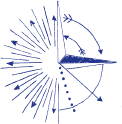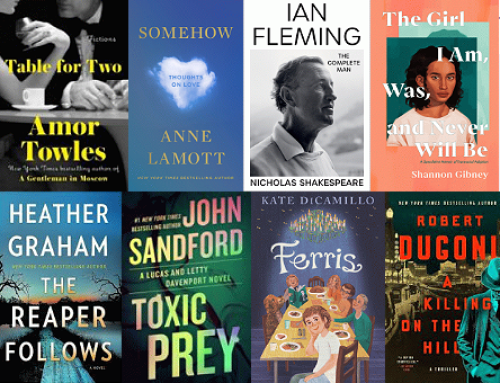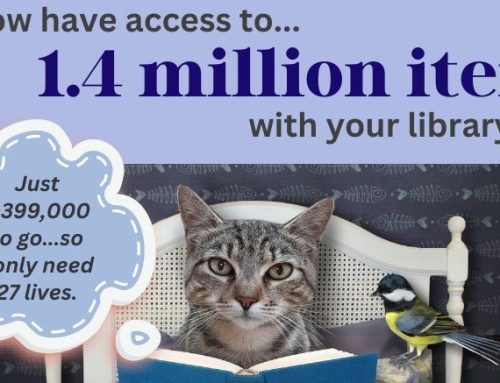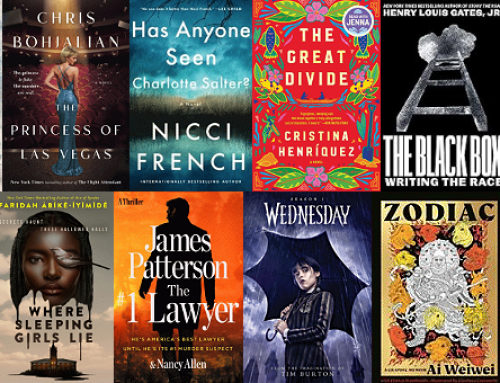
[Special guest post by Chris Appleby, local genealogy expert and library volunteer. Read her profile here and sign up for her free workshop this Saturday — April 27 at 2:00 p.m. Click on the flyer below for details.]
~ ~ ~ ~ ~
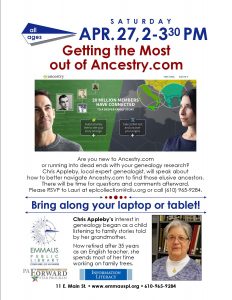 Getting started with family genealogy is easier than you’d think. Step one is to just talk to your family! In particular, talk to the older members. You’ve probably been listening to their stories for most of your life. Go back and revisit those stories with Grandma, Gramps or old Aunt Mildred. Don’t wait, because once those dear, older members of your family are gone, so are their stories. I can’t tell you how often I’ve wished that I could still ask Grammy, Mama or Aunt Theda about something that happened years before I was born.
Getting started with family genealogy is easier than you’d think. Step one is to just talk to your family! In particular, talk to the older members. You’ve probably been listening to their stories for most of your life. Go back and revisit those stories with Grandma, Gramps or old Aunt Mildred. Don’t wait, because once those dear, older members of your family are gone, so are their stories. I can’t tell you how often I’ve wished that I could still ask Grammy, Mama or Aunt Theda about something that happened years before I was born.
To get started, set up a time to talk to Uncle Charlie or Aunt Jane. Tell him/her that you’re interested in learning more about the family and would like to learn all you can from him/her. Since most of us older folk like to reminisce, it shouldn’t be hard to get the conversation going. Start with basics: parents’ and grandparents’ names with birth and death dates. Where your ancestors were born and died is also important. Other information that your relative might be able to furnish might include baptismal information, schooling, occupation, plus names and dates for siblings. For male ancestors, whether they served in the military is important information. Of course you want cold, hard facts, but don’t be afraid to let the conversation drift. Anecdotes about Grandma’s life–where she was when she learned of the D-Day Invasion and how she felt and reacted–are just as important, or maybe more important, than names and dates.
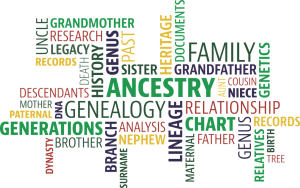 Next comes the hard part: making a record of your conversations with your relatives. This is a vital step. Don’t make the mistake I made many years ago when I started down the genealogical rabbit hole. I figured I could remember where I found my information, and at best, I did very cursory documentation. Often I’d just trust my memory. Well, there was a 30-year break in my research while I raised my family, and when I returned to the hunt, I couldn’t always recall where information came from. And since by then my grandmother–who was my main familial source–had passed away, there was no going back to her. So document, document, document!
Next comes the hard part: making a record of your conversations with your relatives. This is a vital step. Don’t make the mistake I made many years ago when I started down the genealogical rabbit hole. I figured I could remember where I found my information, and at best, I did very cursory documentation. Often I’d just trust my memory. Well, there was a 30-year break in my research while I raised my family, and when I returned to the hunt, I couldn’t always recall where information came from. And since by then my grandmother–who was my main familial source–had passed away, there was no going back to her. So document, document, document!
Probably the simplest way to document a conversation is to take some notes during the interview. The rough notes you take can be cleaned up and fleshed out later. I suggest starting your documentation by placing the name of the person interviewed, their age, and the date and place of the interview in an upper corner of the paper. You might also want to include the person’s relationship to you. A bulleted list of what you learned is probably easier than trying to write up the information in story form. It will also be easier to access your information later.
Another option is to record your conversation with your family member. Start the interview by noting the person’s name, age, etc., on the recording. Afterwards, write up a bulleted list of what you learned from the conversation. An added benefit of a recorded interview is that you have preserved that person’s voice as well as what family information they shared. My cousin did a series of four interviews with my mother and sent me CDs of those interviews. I didn’t really learn anything new from them, but I love hearing my mother’s voice again.
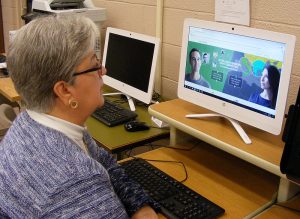 After gathering as much information as possible from talking to relatives, you may be wondering what websites and online tools can help you with the next phase of your research. A great place to start is Ancestry.com, which has the largest available database of online genealogical records. You can come into the library and use the Ancestry.com Library Edition, which is limited in scope but still a helpful tool. Or, you can try the full Ancestry.com home edition, which has many features not found in the library edition.
After gathering as much information as possible from talking to relatives, you may be wondering what websites and online tools can help you with the next phase of your research. A great place to start is Ancestry.com, which has the largest available database of online genealogical records. You can come into the library and use the Ancestry.com Library Edition, which is limited in scope but still a helpful tool. Or, you can try the full Ancestry.com home edition, which has many features not found in the library edition.
Ancestry.com often offers a free trial period, so you can take advantage of that to see if the site would meet your needs before converting to a paid membership. However, a warning: the two-week trial period is hardly enough to scratch the surface of what is available. At my talk on April 27, I’ll go into more detail on how to get the most from Ancestry.com. There are also other websites and local historical resources available to further your search based on what you find, but those are for a future post.
Probably at this point you’re ready to set up a working family tree so you can begin to see how the pieces fit together. You can download a simple tree on which to record your ancestors’ names from the internet. Ancestry.com Library Edition has some very nice printable trees and charts. You can also purchase some very ornate trees later if you want to display your findings when you’ve found most of your ancestors.
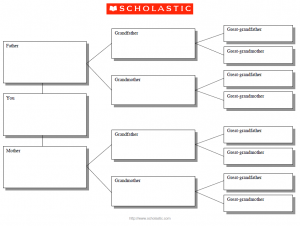 The two most basic types of trees are a pedigree tree (see sample, right) and a descendant tree. I prefer the pedigree tree because I find it easier to work with and much less confusing. A pedigree tree displays only your direct ancestors, i.e., parents, grandparents, great-grandparents and so on. They’re quite easy to follow.
The two most basic types of trees are a pedigree tree (see sample, right) and a descendant tree. I prefer the pedigree tree because I find it easier to work with and much less confusing. A pedigree tree displays only your direct ancestors, i.e., parents, grandparents, great-grandparents and so on. They’re quite easy to follow.
On the other hand, descendant trees list every family member in a generation, so you’ve got not only the direct ancestors, but uncles, aunts, cousins and more. If you’ve ever seen one of those family trees for the kings and queens of England, you’ve probably seen a descendant tree. Such trees have their uses but can be overwhelming and very confusing, especially to beginners.
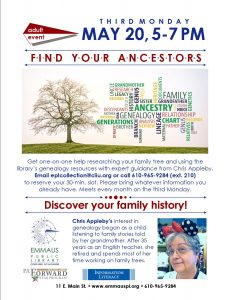 So, if you’re interested in preserving your family history for future generations — or just curious about what long-lost relatives or interesting stories might be hiding in your family tree — hopefully these steps can get you started. I’ll share more in a future post.
So, if you’re interested in preserving your family history for future generations — or just curious about what long-lost relatives or interesting stories might be hiding in your family tree — hopefully these steps can get you started. I’ll share more in a future post.
In the meantime, I hold free one-on-one, half-hour sessions on the third Monday of each month at the library if you get stuck or need some extra help getting started. The next date for those is May 20.
Click on the flyer for details and email eplcollection@cliu.org or call the library at 610-965-9284 to schedule a session.

